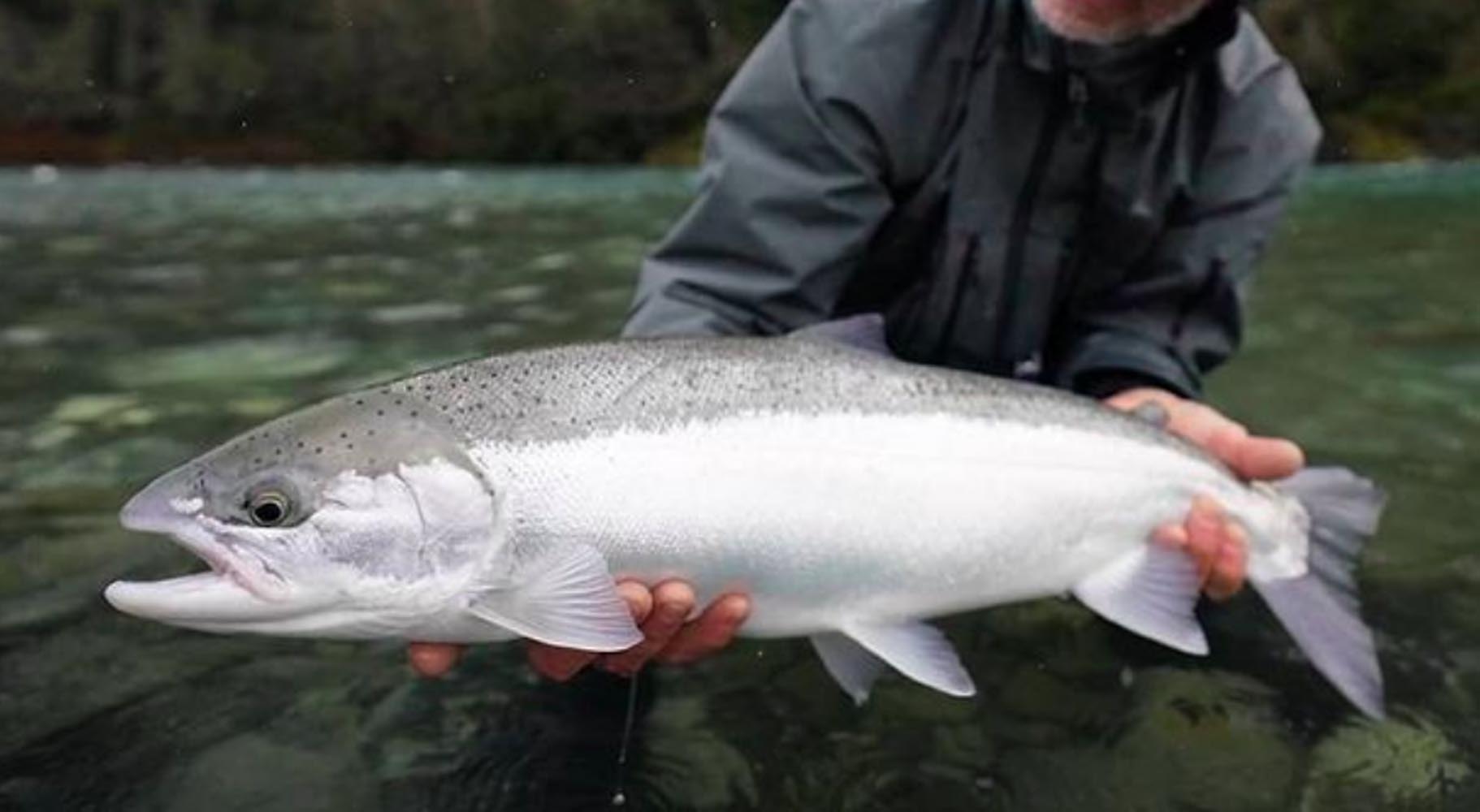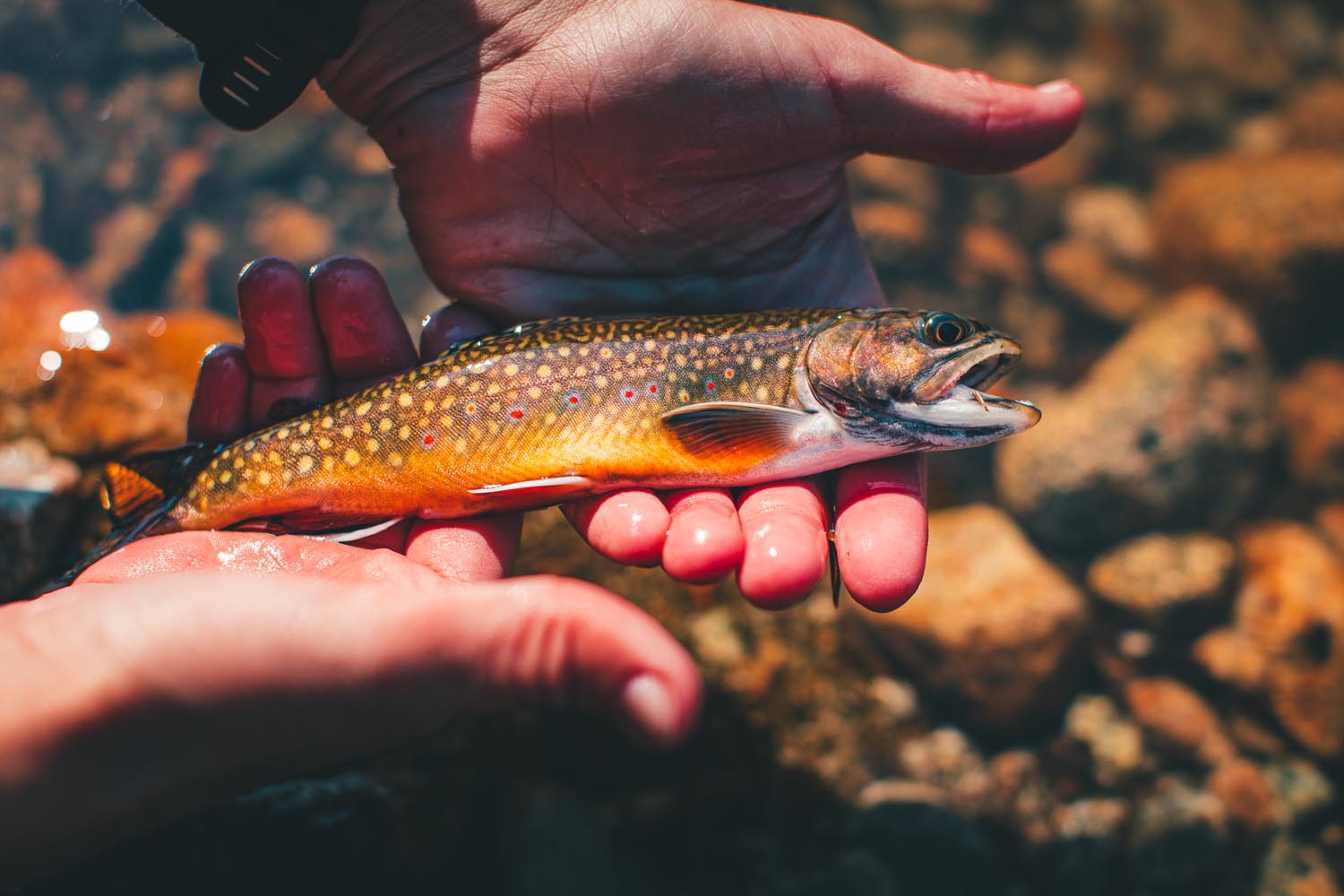Photo credit: IG @The_great_lakes_angler
TROUT (Hippoglossus Stenolepis)
Trout is one of the most popular fish species to target in BC, as they are abundant in all types of systems from rivers to lakes. Trout are fish that thrive in cold clear water, and that is exactly why they thrive in the pacific west coast and in the interior lakes where food is abundant. There are many native species of trout in British Columbia. Trout are excellent game fish as they are known for their aggressiveness, willingness to bite, and acrobatic fighting abilities. The Freshwater Fisheries Society along with the Provincial Government has come together to create a program that stock millions of rainbow trout in the hundreds of lakes that span across BC. This provides exceptional fishing opportunities. Trout can range anywhere from a couple grams (stocked fish) to over 30lb such as anadromous steel head trout.
Here are species of trout that can be found in BC waterways:
RAINBOW TROUT
One of the most popular fish that fresh water anglers target are the Rainbow trout. They are characterized by the small spots across their body and a bright pink stripe running the length of their body, hence the name Rainbow trout. Rainbow trout are stocked regularly across many BC lakes so that anglers can fish them. They can be caught year round. What makes them a great species to target is their aggressiveness and feeding habits, allowing anglers to catch them using many different methods. They can be found in streams, rivers, lakes, sloughs and estuaries. Rainbow trouts can vary in size from a couple grams up to 10+lbs. Their size is usually dedicated by their environment and how much feed is available, for example trout in the interior can grow much faster and larger than those found closer to the coastal lakes due to the amount of insect life that is present. In BC there are 4 substrains of rainbow trout: Fraser Valley, Pennesk, Blackwater and Gerrard rainbow trout.

Photo credits: IG @ motherlode_drifter
SEA-RUN STEELHEAD TROUT
Steelhead trout otherwise known as the Silver Ghost, haunts the Pacific West and the dreams of many anglers who target them. Steelhead trout are actually anadromous rainbow trout, meaning that they are sea-run. Much like salmon, steelhead come back into its native river to spawn before returning back into the ocean. These large sea-run trout can grow in excess of up to 30lbs when returning from the ocean. There are 2 types of steelhead runs: Winter-run and Summer-run. Steelheads are characterized by their silver bodies and large square tail. They have small black dots that run above the lateral line. They are one of the most sought after game fish for any angler due to their massive size and acrobatic fighting capabilities. Many anglers perceive them as a fish of one in a million casts.

Photo credit: IG @coastal_cutty_bum
COASTAL CUTTHROAT TROUT
Coastal Cutthroats are also known as “cutties”. They are considered the wolves of the water as they travel in groups and are extremely elusive, where they might be in one waterway one day and gone the next. Cutthroat trout are named as so due to their appearance of having a orange slash just under their jaw line. They have blue-greenish backs sparkled with many spot black dots. Their average size is about 10” to 18” however some can grow as large as 24” or more. Cutthroat trout can be caught both in freshwater and saltwater and are highly mobile making them a challenging species to target. They can be found in rivers, lakes, beaches and sloughs while following the spawning cycles of other species, feeding off their eggs in the late fall or fry in the spring.

Photo credit: IG @Moshi519
BULL TROUT
Bull trout is a member of the char family, and is a favourite target among fly anglers due to their size, fight and aggressiveness. Bull trout is a species that was threatened by overfishing for decades and finally making a recovery due to protective regulations. This is due to late maturity and low reproductive rates, which makes bull trout a very vulnerable species. Fishing for bull trout has made an extremely strong come back, in the form of catch and release. The bull trout is an anadromous cold water species of trout found in lakes, rivers and streams of British Columbia. Bull trout prefer habitats that provide clean gravel beds, deep cool pools with cover such as logs and branches They are extremely aggressive feeders that feed on other fish and will readily hit lures, flies or bait, however do keep in mind that in BC all bull trout must be released. Bull trout reside in the five large river systems in BC: Fraser canyon, Fraser river, Lillooet River, Squamish river and Skagit river. Bull trout have a greyish green body speckled with white and pink spots that run along their sides, with large broad heads, a slimmer snake-like body and white edges along the lower fins. They can grow as large as 30lbs in some cases with the average size between 2 to 3lbs.

BROOK TROUT
Brook trout otherwise known as “Brookies” are in fact not a trout but a char and native to eastern Canada. They are closely related to lake trout, bull trout and arctic char. They have since been introduced to BC to stock many lakes for over a century. To see which stocking reports for lakes to catch brook trout check out: https://www.gofishbc.com/Stocked-Fish.aspx Brook trout are considered to be one of the most aggressive of the smaller trout species, easily caught with many different lures and flies as they are not picky biters. They are incredible fighters for their size, growing up to the 5lb range. Although they do not grow in length as their other counterparts, they make up for it by their large girth. Brook trout are known for their amazing flesh quality, making for a great table fare.

Photo credit: IG @Berganator94
LAKE TROUT
Lake trout otherwise known as “lakers” can be found in large deep cold water lakes. Lake trout is rather a char rather than a trout species as the name implies. They are aggressive feeders which diet consists of rainbow trout, leeches, crustaceans and kokanee, therefore allowing them to grow up to a meter in length and over 40lbs! The average size is between 40-50 cms or 10lbs. Lake trout are easy to distinguish from other trout by their colour characteristics: dark greenish grey body with yellow spots. They feature an elongated head and body, with a white underbelly and orange fins. Most anglers fish for lake trout by method of trolling on a boat. As these fish are prefer the deep, a lure is usually slowly trolled at 40 feet or deeper. In the spring, lake trout will be closer to the surface, and will go deeper as the weather warms up. As a rule of thumb: 10ft deep just after ice off, 20-30ft deep during mid spring, 30-45ft deep during late spring, and 50+ feet deep in the summer.
THE BEST TIME AND PLACES TO FISH FOR TROUT
As each trout species is somewhat different from one another, there are certain aspects that can be used to achieve success across all trout species:
- Trout prefer cool and clean waters with less than 70°F
- Prefer water that is well oxygenated
- When river fishing, look for deeper pools or pockets where fish can hold
- Dawn and dusk are very productive times to fish for trout
- Fish tend to come into the shallower areas in order to feed on hatching insects
- Look out for insect hatches that happen as this can create feeding opportunities for fish
TIPS TO CATCH TROUT
Trout prefer to feed on small aquatic insects, but larger adults will also prey on other smaller fishes. Part of the reason why trout are so popular as a game fish is due to their willingness to take a variety of baits, both natural and artificial. When fishing for trout during the spring and fall season, trout will often be more active by found near the surface feeding. Trolling with spoons spinners, flies or float fishing with bait is an extremely effective method. When the water warms up during summer, trout become more sluggish and will relocate to depper cooler waters. Therefore fishing near the bottom would be more effective during this time. Troll near the bottom or bottom fishing with bait will usually give you success targeting trout :
- Trout prefer cool and clean waters with less than 70°F
- Picking the right size lure will greatly increase your chance of success, scale down the size of your lure. Typically spoons or spinners in the ⅛ oz size is extremely effective. Spinners and spoons are very effective when trolling or spin casting.
- If you are fishing for stocked trout, remember that these trout have been pellet fed their entire lives. You will not catch any wild trout using powerbait.
- However artificial baits such as powerbaits can be extremely effective on stocked trout.
- The most effective of all, is live bait such as night crawlers, along with minnows and crayfish. Bottom fishing or float fishing with worms is a very effective method.
- Fishing with light or ultralight rods will give you an advantage, using lighter gear such as 4-6lb line will increase your chances of catching trout.
TROUT FACTS
Average sizes: between 2-4lbs with some going over 30lbs. Trout sizes will vary depending on the species and the different waterways.
Habitat and temperature: Trout prefer cool and clean waters with less than 70°F Their habitats range from rivers, lakes, streams, and sloughs, they prefer well oxygenated clean clear waterways.
Biology: Trout are native to British Columbia. They can be found throughout many lakes and connected waterways via their tributaries. The province of BC trout stocking program which is funded by the purchase of our fishing licence has created many opportunities in lakes that were once empty and void of fish. The types of trout stocked at each lake depends on the biology of the lake. Wild trout on the other hand are ready to reproduce at 2 years old. Their colours begin to change to a darker red, as they find mates. Some species mate in the fall while others mate in the spring. A female trout will lay her eggs which are fertilized by the male – in a redd or nest built in the gravels of a stream or river.
